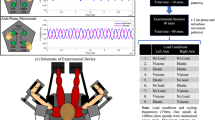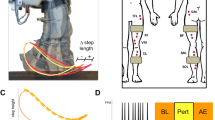Abstract
Two-limb coordination of homologous and non-homologous effectors was examined during isofrequency (1:1) and multifrequency (2:1) conditions. The coordination patterns involved flexion and extension movements in the sagittal plane and were performed under unloaded and single-limb (right arm) loaded conditions. Previous studies suggested that the lower degree of 1:1 synchronization observed during nonhomologous as compared to homologous coordination results from natural differences in biophysical (inertial) properties. Elaborating on this idea, adding weight to the right arm was hypothesized to modulate its inertial characteristics, rendering homologous limbs more dissimilar and nonhomologous limbs more similar by enhancing and decreasing their inertial differences, respectively. Therefore, the observations made during unloaded conditions were predicted to be completely reversed during loaded conditions. Findings revealed that during 1:1 coordination (experiment 1) single-limb loading resulted in a decreased relative phase stability, whereas relative phase accuracy depended upon the limb combination. In particular, phase-locking was more accurately maintained for loaded homologous than for nonhomologous limbs, whereas loading the nonhomologous limbs resulted in a deterioration of the quality of synchronization. These findings suggest that there is an additional explanation of differential coordination capabilities among limb combinations. It is hypothesized that the neural networks subserving the control centers of the homologous limbs are more tightly connected than those of the nonhomologous effectors, allowing 1:1 synchronization to be more successfully preserved in the face of (load) perturbations. During 2:1 coordination (experiment 2), the loading procedure disturbed the coordination dynamics across all limb combinations. That no differential effect of loading on effector combination was observed is possibly a result of the fact that only an initial level of practice was studied in which optimal relative phase dynamics are still being explored for both homologous and nonhomologous limbs.
Similar content being viewed by others
Author information
Authors and Affiliations
Additional information
Received: 7 May 1997 / Accepted: 16 January 1998
Rights and permissions
About this article
Cite this article
Serrien, D., Swinnen, S. Load compensation during homologous and non-homologous coordination. Exp Brain Res 121, 223–229 (1998). https://doi.org/10.1007/s002210050455
Issue Date:
DOI: https://doi.org/10.1007/s002210050455




